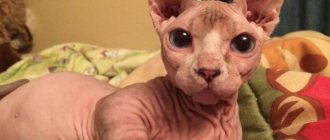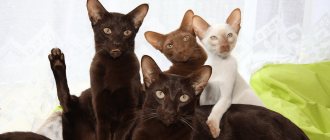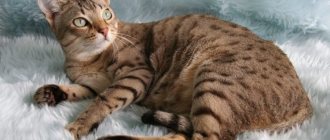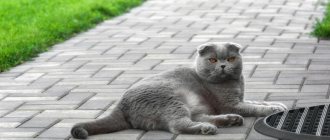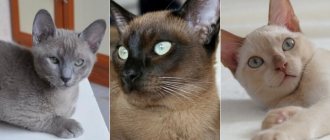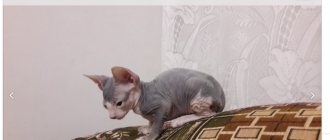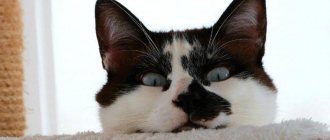Sphynx cats are not always completely hairless. Some animals are born with short hair, resembling velvet or plush in appearance. In most cases, the hair follicles weaken over time and the villi fall out. However, some animals retain fur throughout their lives. It can cover the torso completely or partially. In the article we will look in detail at the features of Sphynx cats with fur and the types of their hair.
Varieties of the Don breed
Representatives of the Don breed are the most diverse in length and density of coat. It is also worth noting a breed peculiarity: in the cold months, hairless cats are covered with short and sparse fluff, and in the warm season they go bald again. There are three types of cats of the Don breed of wool type.
Velor Sphynx
The Don Sphynx of the velor variety has quite long, fleecy hair, which is clearly noticeable when stroking the animal’s body. Fur covers the body from birth, although visually a newborn kitten appears bald.
The furs are hard, puff up when you run your hand against their growth, then return to their original position. A sexually mature Don Sphynx loses a significant part of its fur. Most cats only have their head and limbs covered.
Brush sphinx
If you breed hairless animals, then the combination of dominant genes results in a non-viable litter. Therefore, the Don Sphynx of the Brush variety is the result of crossing hairless and woolly cats. But if you breed two representatives of the brush type, hairless cubs will be born.
A newborn brush kitten is covered with dense, curly hair, which remains or falls out in an adult cat. The external characteristics of the Sphinx Brush are unstable. Representatives of the species are either naked or covered with fur, depending on climatic conditions, diet, and changes in hormonal levels.
The brush variety is characterized by autumn shedding. There are vibrissae, they are curved, which gives the animal a funny look. The coat may be uneven in length and thickness, which gives the Sphynx Brush a somewhat unkempt appearance.
Important! Brush sphinxes have no exhibition value and are not allowed into exhibitions. But they are often used for breeding.
Flock Sphynx
Newborn kittens of the flock variety visually appear bald, but in reality the body is covered with sparse hairs that fit tightly to the skin. To the touch, the flock kitten's body seems velvety.
As the animal grows, the velvet cover becomes thinner and gradually disappears.
Straight-haired cats
Straight-haired Sphynx cats are covered with regular hair. They have straight mustaches. With age, the hair does not fall off; the fur remains forever.
Straight-haired cats are obtained by crossing Sphynxes with Siamese and Oriental breeds. They lack the hairless gene. Despite the presence of hair, straight-haired animals are classified as sphinxes. Their appearance, character and habits are characteristic of this breed of cats. The hair on the body is considered a heritage of Oriental cats.
Straight-haired animals are mainly found among Peterbalds, less often among Don Sphynxes. Sometimes kittens with fur are born to completely hairless individuals. This is due to failures in genetics.
This type of sphinx cannot take part in exhibitions. Straight-haired kittens are discarded from breeding. The presence of permanent hair is considered a deviation from breed standards.
Dimensions and parameters
The Don Sphynx is a cat with a harmonious and graceful physique and a strong skeleton. With its physique and facial features, the Don pet resembles an alien creature.
Body size is average. Height at the withers is 25–30 cm. The male weighs 6–7 kg, the female – 4–5 kg.
Sphynx brushes are divided into three categories based on the thickness of their coat:
- Velor brush. Hairs up to 5 mm long. In an adult cat, the coat becomes flocked: hairs remain on the neck and body.
- Brush point. A newborn kitten has dense fur. After a year of life, the coat is discharged. Short and dense hair remains on the face and tail. The rest of the body is velor.
- Dense brush. The body is covered with dense wool, through which the skin does not show through.
The Sphynx brush can be any color. The most common are red, black, blue, lilac, white, gray, cream, chocolate, and tortoiseshell cats.
Anatomical characteristics (head, nose, eyes, body, paws, tail, whiskers, ears, skin, fur)
Petersburg cats have an elongated body shape, similar to a tube. Shoulders and hips are the same width. The legs are long and slender with rounded limbs with elongated toes.
The head is elongated, but narrow, smoothly passing from the head to the neck. The profile is straight: from the forehead there is a straight line to the tip of the nose, which has a wide shape.
The eyes are delicately almond-shaped, like those of an Egyptian queen. The color is most often blue or green, but can come in other colors.
The ears, wide at the base, slightly taper towards the tips, are set wide apart, have a soft surface of skin covered with hair on the outside, and are uncoated on the inside, pale pink in color.
The tail is like a whip: ideally thin, straight, its thickness almost does not change, there are no kinks.
Vibrissae may or may not be present. This depends on the pet’s coat; some of them do not have eyelashes or whiskers, or have barely noticeable appendages.
Head shape of the St. Petersburg Sphinx
The skin is of the following types:
- straight-haired - regular straight hair of medium length, growing mustache, eyelashes, eyebrows.
- bald - there is no hair everywhere, the skin feels like rubber, there is no mustache, eyebrows, or eyelashes.
- velor - a fine covering of fluff, mainly on the paws, tail, ears, but can be all over the body; the skin feels like terry cloth.
Sphynx with flock hair
- flock - the fur does not exceed 2 mm in length, in some cases there are no eyebrows or whiskers
- brush - newborn kittens are covered with hair, but over time it disappears.
- brush point - newborn kittens have a coat slightly higher than that of the brush type, but over time the body becomes bald, and hair remains only on the paws, tail, ears, and muzzle.
Description of the breed and parameters of the Sphinx Brush
The breed standard for sphinxes is strict. Anatomical and external parameters are shown in the table.
| head | triangular, high cheekbones, narrowed downwards, noticeable brow ridges, flattened forehead, straight nose, prominent whisker pads |
| eyes | medium size, almond-shaped, iris of any possible color for a cat |
| ears | disproportionately large, widely spaced, slightly inclined forward, with a wide base and rounded ends |
| vibrissae | unequal length, curved |
| torso | strong, sinewy, elongated, dignified, harmoniously and gracefully built, with well-developed muscles, straight spine, wide croup |
| limbs | elongated, thin, graceful, oblong paws with long toes |
| tail | long, thin, with a rounded end, without strong bends |
Description of appearance
From birth, small kittens are not very different from adult Sphynx Brush cats. In accordance with the characteristics of the parents' cover, they may have almost bald, thin, sparse skin.
American shorthair cat
Characteristics of the Don breed:
- Straight graceful back.
- Muscular body of medium size.
- Thin paws with well-developed muscles.
- Long, rounded fingers.
- Round and straight tail.
- The eyebrows protrude strongly.
- Big cheekbones.
- The head is wedge-shaped.
- Developed chin.
- Straight nose.
- Flat forehead with vertical folds.
- Pronounced whisker pads.
- The eyes are oval or almond shaped and small in size. The color of the iris may vary.
- The ears are large, round, tilted forward and set high.
- The color can be anything from black to spotted.
- The height of an individual can reach 30 cm, and weight - 3.5-7 kg.
Sphinxes are not prone to any special diseases. Their immunity is able to cope with any disease. Most often, cats suffer from lichen and helminths. Therefore, it is recommended to regularly carry out preventive measures.
Average lifespan
With proper care, the Don Sphynx lives 13–15 years. Obesity significantly reduces life expectancy, which causes diseases of the joints, heart, blood vessels, and digestive organs.
In order for your pet to remain healthy and live a long time, it is necessary to regularly take it to the veterinarian for preventative checks. At 6 weeks of age, the kitten is vaccinated against distemper, calcivirosis and rhinotracheitis.
At the 8th week of life, the pet is given a vaccine against rabies, at the 12th - against leukemia, at the 13th - against chlamydia. A one-year-old kitten is revaccinated, then the vaccinations are repeated annually. Before vaccination, the pet is given tablets to prevent helminthiasis.
Origin story
The flock variety of the breed appeared thanks to such pets.
The ancestor of the breed was first seen in the Russian Federation, in Rostov-on-Don, in 1988. The first assumption was that the animal was suffering from some terrible disease due to the almost complete absence of fur. Afterwards they thought that the cat had suffered severe stress, as a result of which it became bald. When kittens without fur were born in the first litter, they got rid of them, considering them a mistake of nature. However, one baby was able to survive and the continuation of this breed began from him. A year later, people took a closer look at the cats, and began to consider them a rare and unique breed, then they started breeding them and sold them for a lot of money, and soon it became a profitable business. The Don Sphynx was crossed with short-haired breeds, as a result of which the so-called flock cat appeared, due to its curly hair. This breed was officially approved by the WCF organization only at the beginning of 2000, therefore the breed is considered young.
Character of the breed
The Don Sphynx is affectionate, gentle, requiring care and communication. This is a completely non-aggressive animal, but touchy and vulnerable. The Sphynx Brush needs the owner's attention and loves to sit on a person's lap. He can be obsessive when petting him, but quickly realizes that the owner is busy and cannot pay attention to him.
By temperament, the Don Brush pet is sanguine. He is sociable, friendly, inquisitive, non-conflict. If he is not busy with an exciting activity or game, he dozes off in a cozy place.
The Don Sphynx is a wonderful partner for children's games. He willingly participates in children's undertakings, is patient with pampering, and will not allow himself to show aggression towards the child. The Sphinx's attitude towards other domestic animals is loyal and friendly. The pet is ready to share a home with large non-aggressive dogs, and with decorative rodents, and with birds.
Peculiarities
The skin of hairless Peterbalds is sensitive to ultraviolet radiation. But despite this, he loves to sunbathe and spend a lot of time in the warmth. To prevent burns, the skin must be wiped with baby oil.
Peterbalds love to be in the sun.
Hairless cats' own natural defense is to secrete a brown liquid, which must be removed with a damp towel or napkins, otherwise marks may remain on furniture, textiles or interior items.
With a complete absence of hair, the color on the skin looks like a tattoo, like a “shadow of color.”
Also unusual is that while lacking fur, they may lack whiskers, eyelashes and eyebrows.
Hairless petriks are similar to rubber ones, since their skin is elastic, but sticky, which is especially noticeable when touched.
Care and maintenance
There are no difficulties in caring for the Sphynx Brush. But care must be regular.
| eyes | The teardrops are cleaned daily with a lint-free cloth moistened with boiled water or chamomile infusion |
| ears | clean it twice a week with a cotton swab moistened with veterinary ear lotion, but you should not go deep into the ear with a cotton swab, so as not to injure the internal tissues |
| claws | cut with a nail clipper as they grow, the procedure is carried out with extreme caution so as not to touch living tissue with blood capillaries |
| teeth | Clean 2 times a week with a soft brush using veterinary paste. |
| body | bathing is carried out 2 times a month; to clean the delicate fur of the brush, use baby soap or pet shampoo with an antibacterial effect |
Advantages and disadvantages
Any breed can have its pros and cons, but each quality can very conditionally be good or bad.
- Presence of wool. For those who fell in love with sphinxes precisely for their “baldness,” this will certainly be a minus. But for those who don’t want to give up the fluffiness of cats so abruptly, this is definitely a plus.
- Unusual appearance. Also - both a plus and a minus. Some people are frightened by such “aliens,” while others are their ardent fans.
- No special care required. This is definitely a plus! And all cats need their ears cleaned and their nails trimmed.
- Sociability. It's hard to say whether this will be a plus or a minus. If you are often at home or, in principle, someone is always at home, then there are no special problems. And if the apartment is often empty because you are constantly leaving somewhere, then it is better to think about a different breed.
- Playfulness. Also - both a plus and a minus. Not all people are comfortable with excessive activity, and some people love to watch cats play.
- Excellent attitude towards all family members. And other pets also fall into this category. This is a huge and unconditional plus! Few breeds can boast of this.
Always choose a pet you like. If you are fascinated by brushes, then you should definitely get one for yourself. Don't get an exotic cat just out of curiosity or as an experiment. Make your choice responsibly: find a good nursery, talk to the breeders, ask them about all the features.
Diet
The Donskoy pet must eat a lot, since its body, covered with light brush hair, actively gives off heat, and metabolism in the body proceeds at a high speed. But overfeeding is unacceptable, otherwise the animal will become obese.
You can feed your Sphynx with store-bought food of the premium, superpremium or holistic categories, and with natural products. In the second case, the diet includes:
- lean meat;
- sea fish;
- boiled eggs;
- cereal porridge;
- fermented milk products;
- vegetables.
Note! A kitten up to 3 months old should eat 5 times a day, a six-month-old kitten should eat 4 times, and an adult Sphynx should eat 3 times.
The Sphinx should not be treated to fatty meat, fried food, river fish, bones, smoked meats, pickles, sausages, sweets, bread products, or waste from the master's table.
Health
The Donskoy pet Brush is distinguished by good health. But due to his short hair, he is susceptible to colds. Therefore, a brush cat should not be kept in a draft or walked in cool weather.
Representatives of the Don breed have a strong heart, but dermatological pathologies can arise due to illiterate care and an allergic reaction.
The following breed defects are characteristic of sphinxes:
- microphthalmia (abnormally small size of the eyeball);
- shortened lower jaw;
- turning of the eyelids;
- deformation of the caudal vertebrae;
- hyperplasia (proliferation) of the mammary glands;
- vasculitis (cutaneous form).
Attention! A genetic anomaly characteristic of Sphynx cats is the underdevelopment of the thymus gland, which is responsible for the functioning of the immune system. With this pathology, the kitten dies at an early age.
Communication with the velor miracle
At first glance, any Sphynx, even a short-haired one, seems very stern and a little angry. But this is just the first impression! In everyday life, these “aliens” are the kindest and most loyal cats you can imagine. They fanatically love their family and prefer to sleep in the same bed with them; they especially love to lie under the covers with their owners. For these features, sphinxes are sometimes called cotops.
Brush kittens are incredibly active, curious and sociable. The baby uses for games everything that rolls, runs or simply moves. With age they become calmer and more stately. Sometimes they sit stretched out for a long time, curling their tail into a ring on their body. Because of this feature, guests who have not noticed the pet may be frightened if the “figurine” suddenly moves.
Both the Peterbald Brush and the Don Brush get along very well with children. It is rare to note any aggression, since the animal’s “contact” is brought up from childhood. Sphynxes are all very sociable, and if a kitten is isolated from human interaction for a long time, it can become aggressive and unsociable. Any pet needs to be constantly looked after.
This breed does not have any learning problems. They easily remember where their toilet is, what they can and cannot play with, and how to use a scratching post. At the same time, the baby should not be scolded or beaten too much. The purr is very dependent on the person and incredibly longs to be loved by him. It is enough to talk to the sphinx and show what is acceptable and what is not.
Brushes also get along well with other animals, if they do not show negativity towards them. They will play with them, sleep next to them, and even lick them. But you need to be careful if rodents or birds live in the house. Although it seems that this breed is decorative, in fact they are very good and sensitive hunters. Small animals will only be safe if they are in a cage. They don’t mind hunting flies or other insects, or birds outside the window. Often, when the victim is out of reach, Brush sphinxes begin to “quack” very funny, looking at a pigeon or titmouse through the glass.
At first glance, any Sphynx, even a short-haired one, seems very stern and a little angry. But this is just the first impression! Source: Flickr (Yana)
Choosing a kitten
You should buy a kitten when it is 3 months old. By this age, he becomes strong and independent, knows how to use a scratching post and a tray.
Buy a pet from a nursery or at an exhibition. The seller must provide the buyer with a pedigree and a veterinary passport with entered vaccination data.
A healthy kitten is selected based on the following characteristics:
- friendly, fearless, non-aggressive, lively, inquisitive behavior;
- a well-fed, harmoniously built body;
- clean eyes, ears, nose, anal area;
- elastic abdomen without inflammation and knots;
- soft brush wool that evenly covers the entire body;
- absence of bald spots, traces of parasitic and dermatological diseases.
How to raise a Don Sphynx?
Establishing a relationship with him begins from the moment he first crosses the threshold of your home. From now on, the animal should be under your control. Remember that the leader in this union is always you. Do not give up the dominant role to your pet, otherwise he will sit on your neck and manipulate you.
Immediately teach the kitten what is good and what is bad. Then, as an adult, he will not play pranks. If your baby didn't scratch the wallpaper as a child, he won't do it when he turns into a big cat.
Punishment
The animal’s psyche is designed in such a way that it does not perceive brute force. If you start beating him for the slightest offense, you will only do harm.
To show your pet that such behavior is unacceptable, sprinkle it with water from a spray bottle. Another good technique is switching attention. Involve your mischievous child in a new activity or give him his favorite toy. There is no use shouting at him. understands strict intonation much better , but without raised tones.
Promotion
You can always come to an agreement with the Sphinx. It is also useful to reward him for good manners and a calm attitude towards hygiene procedures. If your baby nobly endures bathing, nail trimming, and ear cleaning, praise him and give him a treat. Treats will also come in handy when your pet learns to go to the toilet on its own.
